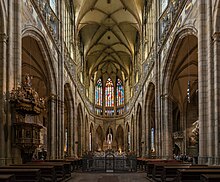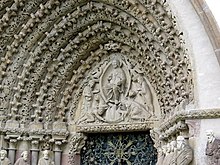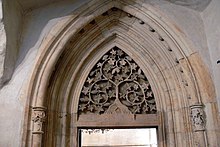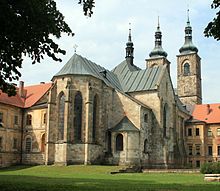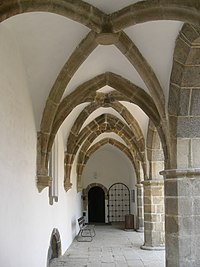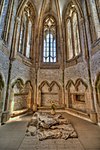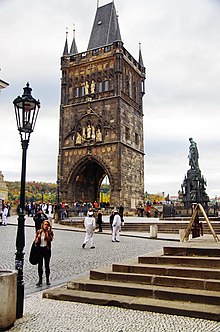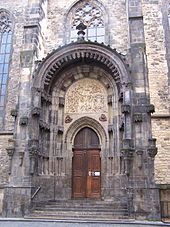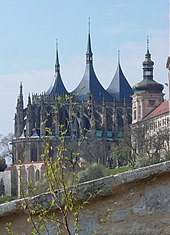
The Metropolitan Cathedral of Saints Vitus, Wenceslaus and Adalbert is a Catholic metropolitan cathedral in Prague, and the seat of the Archbishop of Prague. Until 1997, the cathedral was dedicated only to Saint Vitus, and is still commonly named only as St. Vitus Cathedral.
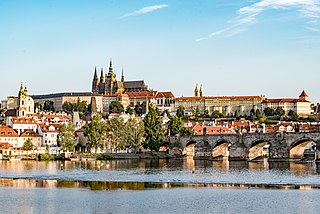
Prague Castle is a castle complex in Prague, Czech Republic serving as the official residence and workplace of the president of the Czech Republic. Built in the 9th century, the castle has long served as the seat of power for kings of Bohemia, Holy Roman emperors, and presidents of Czechoslovakia. As such, the term "Prague Castle" or simply the "Castle" or "the Hrad" are often used as metonymy for the president and his staff and advisors. The Bohemian Crown Jewels are kept within a hidden room inside it.
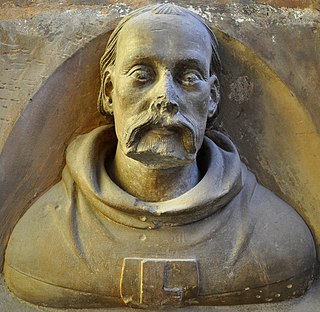
Peter Parler was a German-Bohemian architect and sculptor from the Parler family of master builders. Along with his father, Heinrich Parler, he is one of the most prominent and influential craftsmen of the Middle Ages. Born and apprenticed in the town of Schwäbisch Gmünd, Peter worked at several important late Medieval building sites, including Strasbourg, Cologne, and Nuremberg. After 1356 he lived in Prague, capital of the Kingdom of Bohemia and seat of the Holy Roman Empire, where he created his most famous works: St. Vitus Cathedral and the Charles Bridge.

Benedikt Rejt was a leading medieval architect in Bohemia, today's Czech Republic. He built Vladislav Hall (1497–1500) in Prague Castle, St. Barbara's Church, Kutná Hora, and other buildings in a late Gothic and early Renaissance style.

The Cathedral of St. Bartholomew, originally the Church of St. Bartholomew, is a Gothic church located on the Main Square in Plzeň, Czech Republic. It was probably established together with the city around the year 1295. The church became a cathedral in 1993, when the Plzeň diocese was created. It was designated a national cultural monument of the Czech Republic in 1995.

St. George's Basilica is the oldest surviving church building within Prague Castle, Prague, Czech Republic. The basilica was founded by Vratislaus I of Bohemia in 920. It is dedicated to Saint George. Primarily Romanesque in style, it is part of the collection of buildings that comprise the castle, the political capital of the nation, and the spiritual center of the Czech state.

The Church of the Assumption of Our Lady and Saint John the Baptist is a Gothic and Baroque Gothic church north-east of Kutná Hora in the Czech Republic and is listed in the UNESCO World Heritage List together with the Church of St. Barbara and other monuments in Kutná Hora. It is one of the most important Czech Gothic buildings built in the time of the last Přemyslids and also a very important and one of the oldest examples of the Baroque Gothic style.
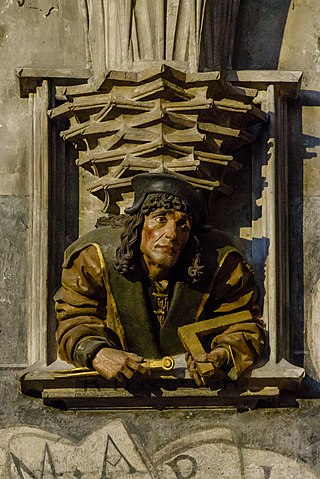
Anton Pilgram was a late medieval Moravian and subsequently Austrian architect and sculptor active in the area of today's Czech Republic (Moravia), Austria and western (Germany) Swabia. Pilgram is known as the sculptor of the portal of Old City Hall and St. James church in Brno and craftsman of the pulpit in St. Stephen's Cathedral, Vienna. He spent a major part of his life in Brno, Moravia.

Saint James` church is a late Gothic three-nave church situated in James' square in the centre of Brno, in Czech Republic. Its history starts in the beginning of the 13th century. The church was categorized as a national monument in 1995.

Czech art is the visual and plastic arts that have been created in the Czech Republic and the various states that formed the Czech lands in the preceding centuries. The Czech lands have produced artists that have gained recognition throughout the world, including Alfons Mucha, widely regarded as one of the key exponents of the Art Nouveau style, and František Kupka, a pioneer of abstract art.

Czech Baroque architecture refers to the architectural period of the 17th and 18th century in Bohemia, Moravia and Czech Silesia, which comprised the Crown of Bohemia and today constitute the Czech Republic.
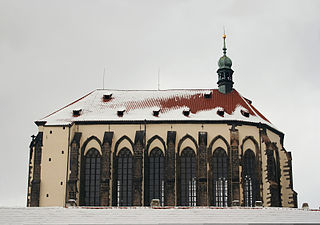
The Church of Our Lady of the Snows is a Catholic church established in 1347 near Jungmann Square in Prague, Czech Republic. It is operated by the Franciscans and was the site of the murders of the Martyrs of Prague in 1611.

Dominican Monastery is the oldest gothic monument in České Budějovice. It consists of Church of Presentation of Virgin Mary and town fortifications. It is situated in south-western part of the historic centre between Street Česká, the bank of the river Malše and the Piaristic square were used to be the town cemetery. Today, the monastery belongs to the cultural heritage of the Czech Republic and there is placed the Artistic school.

Czech Renaissance architecture refers to the architectural period of the early modern era in Bohemia, Moravia and Czech Silesia, which then comprised the Crown of Bohemia and today constitute the Czech Republic. The Renaissance style flourished in the Czech lands from the late 15th century to the first half of the 17th century.
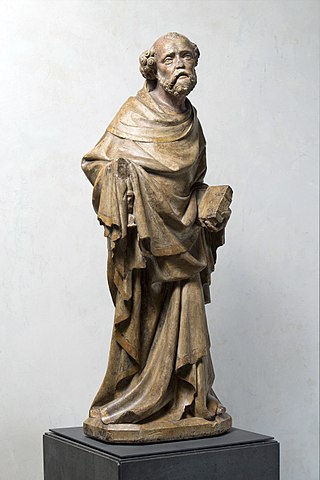
The sculpture of St. Peter of Slivice comes from the Church of St. Peter in Slivice, founded by Jan of Jenštejn, Archbishop of Prague, in 1362. It ranks among early works by the "Master of the Krumlov Madonna" and is exhibited on loan at the permanent collection of the National Gallery in Prague.

Sedlec Abbey is a former Cistercian monastery in Sedlec, part of Kutná Hora in the Czech Republic. Founded in 1142, it was the first Cistercian foundation in Bohemia. Along with the rest of the Kutná Hora town centre, it was listed as a UNESCO World Heritage Site in 1995, because of its outstanding Baroque architecture. It is well known for housing the Sedlec Ossuary.

The following outline is provided as an overview of and topical guide to Prague:

The Church of the Assumption of the Virgin Mary and St. Charles the Great is located in the Karlov area of Prague. The originally Gothic church was rebuilt and augmented in baroque style. The church is a part of the former convent of the Augustinian Order in Prague's Karlov.
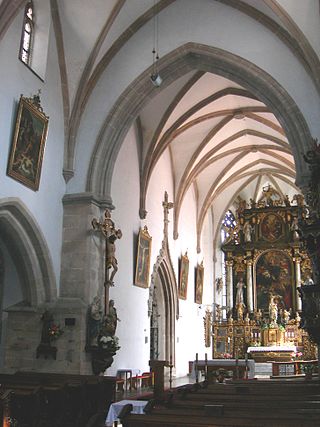
The Franciscan Monastery is located near the Main Square in Plzeň, Czech Republic. Originally belonging to the Minorites, the later Franciscan monastery was founded at the end of the 13th century. The Church of the Assumption of the Virgin Mary, Chapterhouse and Chapel of St. Barbara also belong to the monastery complex.

Czech architecture, or more precisely architecture of the Czech Republic or architecture of Czechia, is a term covering many important historical and contemporary architectural movements in Bohemia, Moravia, and Silesia. From its early beginnings to the present day, almost all historical styles are represented, including many monuments from various historical periods. Some of them are UNESCO World Heritage Sites.
